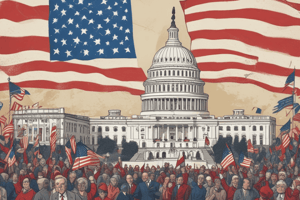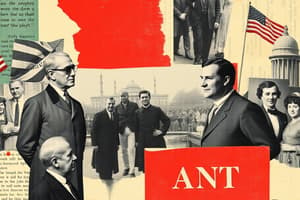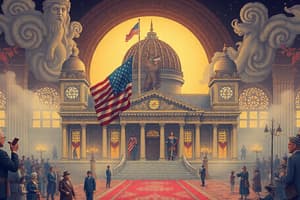Podcast
Questions and Answers
What is the purpose of political parties?
What is the purpose of political parties?
To elect like-minded individuals
What was the Era of Good Feelings?
What was the Era of Good Feelings?
Time of political unity and economic prosperity
Which event created the Democratic party?
Which event created the Democratic party?
- The tea party
- Lack of trust and support in the establishment (correct)
- The great depression
- The civil war
When did Jackson win the election with more voters participating?
When did Jackson win the election with more voters participating?
Which of the following did Democrats support in 1828?
Which of the following did Democrats support in 1828?
What led to the collapse of the Whigs?
What led to the collapse of the Whigs?
What event happened in 1860?
What event happened in 1860?
During the period of 1860-1932, The party was less important than the candidate.
During the period of 1860-1932, The party was less important than the candidate.
During the Party politics era, the North was Democratic.
During the Party politics era, the North was Democratic.
The political process is controlled by the government in the modern era.
The political process is controlled by the government in the modern era.
What is a referendum?
What is a referendum?
What happens during canidate-led elections?
What happens during canidate-led elections?
What is a dramatic shift in voting patterns and preferences called?
What is a dramatic shift in voting patterns and preferences called?
When was the rise of populism?
When was the rise of populism?
Which of the following is a true statement about a national party?
Which of the following is a true statement about a national party?
Which of the following are activities of political parties?
Which of the following are activities of political parties?
How often does party policy need to be formulated?
How often does party policy need to be formulated?
Which of the following influence a person's beliefs?
Which of the following influence a person's beliefs?
Coasts are typically more conservative than Middle America.
Coasts are typically more conservative than Middle America.
What are minor parties focused on?
What are minor parties focused on?
What drives political ideas apart?
What drives political ideas apart?
Which of the following is a consequence of political division?
Which of the following is a consequence of political division?
What is the general ideology of the libertarian party?
What is the general ideology of the libertarian party?
What is the Green Party's major focus?
What is the Green Party's major focus?
What does a straw poll do?
What does a straw poll do?
When creating a poll, what are some things you need to determine?
When creating a poll, what are some things you need to determine?
Why should you do stratified sampling?
Why should you do stratified sampling?
What is the most accurate but least effective method to conduct a survey?
What is the most accurate but least effective method to conduct a survey?
What do you need to do after acquiring data from a survey?
What do you need to do after acquiring data from a survey?
It is good to poll a topic which you know nothing about.
It is good to poll a topic which you know nothing about.
Competitive seats can influence policy & actions.
Competitive seats can influence policy & actions.
Flashcards
Political Party
Political Party
An organized group with shared beliefs that aims to elect like-minded individuals.
Era of Good Feelings
Era of Good Feelings
A period of national unity and economic growth in the United States.
Corrupt Bargain (1824)
Corrupt Bargain (1824)
A perceived unethical agreement in the 1824 election that led to distrust in the political establishment.
Democratic Party (origins)
Democratic Party (origins)
Signup and view all the flashcards
Whig Party
Whig Party
Signup and view all the flashcards
Republican Party (creation)
Republican Party (creation)
Signup and view all the flashcards
Party Politics (1860-1932)
Party Politics (1860-1932)
Signup and view all the flashcards
Political Machines
Political Machines
Signup and view all the flashcards
The Modern Era (Political)
The Modern Era (Political)
Signup and view all the flashcards
Party Realignment
Party Realignment
Signup and view all the flashcards
Critical Elections
Critical Elections
Signup and view all the flashcards
Secular Realignment
Secular Realignment
Signup and view all the flashcards
Party Chairperson
Party Chairperson
Signup and view all the flashcards
DNC and RNC
DNC and RNC
Signup and view all the flashcards
National Convention
National Convention
Signup and view all the flashcards
Delegates
Delegates
Signup and view all the flashcards
Superdelegate
Superdelegate
Signup and view all the flashcards
Getting Political Power
Getting Political Power
Signup and view all the flashcards
Formulating Policy
Formulating Policy
Signup and view all the flashcards
Party Identification
Party Identification
Signup and view all the flashcards
Political Socialization
Political Socialization
Signup and view all the flashcards
Group Affiliations
Group Affiliations
Signup and view all the flashcards
Minor Parties
Minor Parties
Signup and view all the flashcards
Proportional Voting
Proportional Voting
Signup and view all the flashcards
Ranked Choice Voting
Ranked Choice Voting
Signup and view all the flashcards
Polarization
Polarization
Signup and view all the flashcards
Public Opinion
Public Opinion
Signup and view all the flashcards
Public Opinion Polls
Public Opinion Polls
Signup and view all the flashcards
Straw Poll
Straw Poll
Signup and view all the flashcards
Push Polls
Push Polls
Signup and view all the flashcards
Study Notes
- Political parties are organized groups sharing beliefs to elect like-minded individuals.
- The Era of Good Feelings was a time of political unity and economic prosperity.
- A corrupt bargain led to a lack of trust and support in the establishment in 1824.
- This situation created the Democratic Party.
- Andrew Jackson won in 1828 with more voters participating.
- The Democratic Party began to grow, supporting the South and pro-slavery views.
- The Whig Party collapsed due to competing slavery and business interests.
- The Republican Party was created in 1852.
- 1860 marked the beginning of the Civil War.
- Party politics in 1860-1932 prioritized the party over the candidate.
- There were clear political lines, with the North being Republican and the South being Democratic.
- Stability in parties was due to political machines, which built loyalty and support through jobs.
- The Modern Era (1932-present) saw political processes increasingly controlled by the government.
- This includes the use of referendums, recalls, and direct election of senators.
- Candidate-led elections allow the candidate to direct the party.
- Voters tend to ignore issues if they like the candidate.
- Growth of suburbs occurred.
- Party realignment involves dramatic shifts in voting patterns and preferences.
Critical Elections
- 1800: led to one-party politics
- 1828: led to the rise of populism
- 1860: led to Civil War/sectionalism
- 1932: led to Depression/rise of "big" government
- 1968: led to the Southern Strategy
- 2012: led to Tea Party politics
- Secular realignment involves smaller, more local changes.
Organization of Parties
- National Party comprises chairperson and committees.
- The chairperson is the primary spokesperson.
- The committee includes the DNC and RNC, which oversee conventions and distribute funds.
- The National Convention happens every four years to select presidents and VPs and sets the party platform.
- Delegates support the candidate who won the primary.
- Superdelegates are free agents.
- State and local levels include state central committees, congressional district committees, city and county committees, precinct and ward committees, activists, volunteers, and voters.
Activities of Political Parties
- Gaining political power includes selecting candidates, raising money, and mobilizing support.
- Formulating policy happens every four years, outlining the party's goals.
- Organizing of party involves Congress, the Presidency, Courts, and States.
- Party identification is shown through voting affiliation with a political party.
- Political socialization shapes beliefs via parents, friends, marriage, children, job, and economic status.
- Group affiliations are influenced by geography (coasts more liberal, middle America more conservative), gender, race/ethnicity, age, social and economic status, religion, and marital status.
- Minor parties focus on specific issues, using proportional and ranked-choice voting.
- Polarization is a division that drives political ideas apart, leaving no more liberal Republicans or conservative Democrats.
- It's caused by a decline in good citizenship, a 24-hour news cycle/social media, homogenous communities, more polarized candidates, and clear articulation.
Consequences of Polarization
- Less productive government
- Increase in biased info
- Lack of government integrity
- Lack of strong policy
- Minor (third) parties struggle to gain traction but may steal from major parties.
- Usually, minor parties have a narrow focus, compelling candidates or ideas.
- The Libertarian Party focuses on individual liberty and limited government.
- It supports a free market, non-interference in private lives, and privatizing most services outside of foreign affairs.
- The Green Party focuses on environmental issues (green economy).
- It advocates for renewable energy, a living wage, affordable housing, non-interventionism, demilitarization, and a sustainable society.
Public Opinion
- Thoughts are on any key issues or policy.
- Public opinion polls are surveys or interviews aimed at determining the public's stance.
- Straw polls are informal surveys to get quick feelings on issues.
- Straw polls can misconstruct who is sampled and depend on the timing and self-selection of those polled.
How to Create Polls
- Determine content and phrasing, avoiding bias and push polls.
- Push polls persuade people to feel a certain way.
- Deciding who will be asked uses random sampling, which may not reflect the actual population.
- Stratified sampling divides into subgroups and weighs against national averages.
- Phone calls are basic, allow for daily tracking, and involve protected speech.
- In-person polling is most accurate, detailed, and hardest but creates bias.
- Internet polling is most popular, easiest, and can lead to extreme results taken over by bots.
- Analyzing data involves breaking down info to inform decision-making.
Shortcomings of Polling
- Survey error (margin of error)
- Limited response choices (a good poll has 5-7)
- Lack of info (no knowledge on the topic)
- Measure intensity
- Lack of interest
Why Poll?
- There is still good polling, random and diverse.
- Polling can influence policy and action in competitive seats.
- Can be used to overcome outside influences like lobbying.
Studying That Suits You
Use AI to generate personalized quizzes and flashcards to suit your learning preferences.




